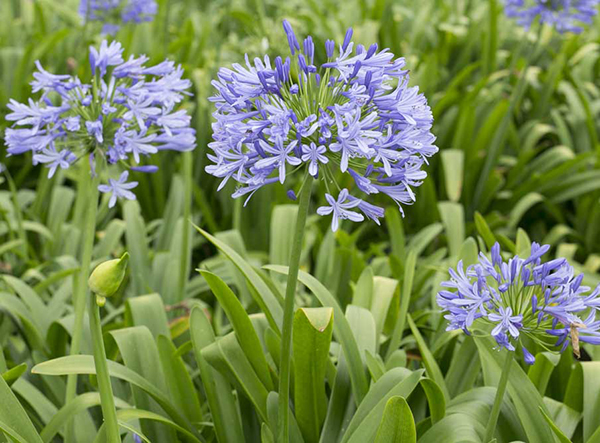How to Plant and Maintain Agapanthus in Your Garden
How to Plant and Maintain Agapanthus in Your Garden
Blog Article
Releasing the Secret to Effective Agapanthus Growing: Tips and Techniques for a Flourishing Yard
In the world of horticulture, growing agapanthus effectively requires a strategic approach that encompasses various facets of plant treatment. With cautious interest to information, one can open the tricks to nurturing these spectacular blossoms, causing a yard that flourishes with charm and vibrancy. By understanding the subtleties of agapanthus growing, one can create a setting where these plants flourish and grow perfectly. In the adhering to conversation, we will check out necessary suggestions and tricks that will certainly guide you in the direction of a thriving agapanthus yard, using insights right into best techniques, soil problems, sprinkling methods, and extra.
Planting Agapanthus: Finest Practices
When growing Agapanthus, proper soil prep work is vital for ensuring effective growth and development of these attractive flowers. Agapanthus, generally referred to as Lily of the Nile or African lily, thrives in well-draining dirt with a slightly acidic to neutral pH level - Agapanthus. Prior to growing, it is critical to change hefty clay soils with natural matter such as compost or peat moss to boost drainage and give vital nutrients for the plants
To grow Agapanthus, choose a location that receives complete sunshine to partial shade, as this will certainly advertise healthy development and bountiful flowering. Dig a hole two times the diameter of the plant's root sphere and position the Agapanthus at the same depth it was previously expanding. Delicately backfill the hole with dirt, weighing down firmly to remove any air pockets around the roots.
Water the newly planted Agapanthus thoroughly and continue to keep the dirt uniformly damp, particularly throughout the plant's energetic growing season. Agapanthus. Applying a balanced fertilizer once a month can even more support the plant's growth and blooming. By adhering to these ideal practices for planting Agapanthus, you can develop a magnificent display of these exciting blossoms in your yard
Suitable Soil Conditions for Agapanthus
For ideal growth and blooming success of Agapanthus plants, ensuring the dirt conditions are suitable is essential. Agapanthus prefers dirt that is rich in nutrients, so integrating a balanced fertilizer throughout the growing season can promote healthy and balanced growth and dynamic blooms.
:strip_icc()/snow-storm-agapanthus-18f19b9a-3e7c6c88441b4127a9015f9a9fecec59.jpg)
Watering and Fertilizing Tips
To make sure healthy growth and vibrant blooms, proper watering and feeding methods are necessary for successful Agapanthus cultivation. Agapanthus plants profit from normal watering, particularly throughout the growing period.
When it comes to feeding Agapanthus, a well balanced fertilizer with equal parts nitrogen, phosphorus, and potassium can be used in the spring to advertise healthy and balanced development and flowering. Slow-release plant foods are suitable for supplying nutrients gradually over a prolonged duration. Prevent over-fertilizing, as this can cause extreme foliage development at the expense of blossoms.
Furthermore, including raw material like compost right into the soil can improve nutrient degrees and enhance soil framework, assisting in the general health of the Agapanthus plants. By complying with these watering and feeding ideas, gardeners can ensure their Agapanthus plants flourish and generate spectacular display screens of flowers.
Pruning and Deadheading Methods
Proper trimming and deadheading techniques play an important duty in preserving the wellness and looks of Agapanthus plants, complementing the crucial practices of watering and feeding for effective growing. Pruning Agapanthus includes getting rid of spent blossom heads, dead or yellowing fallen leaves, and total shaping of the plant to promote better growth. Deadheading, the procedure of getting rid of discolored blossoms, not only improves the plant's look however additionally encourages additional growing.
When deadheading Agapanthus, it is recommended to clip off the blossom next page stem at the base making use of sharp, clean shears. This procedure redirects the plant's energy from seed manufacturing back right into origin and foliage growth, promoting a much healthier and much more durable plant. Normal deadheading can expand the blooming period of Agapanthus and avoid self-seeding, which can cause congestion.
In terms of pruning, Agapanthus typically gain from a light trim after blooming to clean up the plant and encourage fresh growth. Cutting down the invested flower stems and eliminating any dead or damaged foliage aids keep the plant's vitality and overall appearance. However, it is important to prevent cutting right into the crown of the plant, as this can damage its health and wellness.

Protecting Agapanthus From Pests and Diseases
Implementing reliable bug and condition administration approaches is crucial to securing the wellness and vitality of Agapanthus plants in growing. One why not try this out common parasite that impacts Agapanthus is the Agapanthus borer, a caterpillar that passages right into the plant, causing damage to the blossoms and leaves.
In enhancement to insects, Agapanthus are prone to conditions such as root rot and fungal fallen leave spots. These useful content problems can frequently be avoided by making certain proper drain and preventing overwatering. If indicators of condition appear, impacted parts of the plant need to be quickly eliminated to stop more spread. Fungicides may likewise be made use of as a therapy measure, complying with the supplier's guidelines thoroughly. By staying alert and dealing with bug and condition concerns without delay, gardeners can assist their Agapanthus flourish and thrive.

Verdict
In conclusion, effective farming of agapanthus needs correct planting techniques, excellent dirt conditions, ample watering and fertilizing, normal pruning and deadheading, and security from parasites and diseases. By adhering to these suggestions and tricks, gardeners can guarantee a prospering yard filled with stunning agapanthus blossoms. Agapanthus. Remember to preserve regular care and attention to detail to advertise the wellness and longevity of these spectacular plants
When growing Agapanthus, proper soil prep work is crucial for ensuring successful growth and advancement of these stunning blossoms.Water the recently planted Agapanthus completely and proceed to maintain the soil uniformly damp, particularly throughout the plant's energetic expanding period.For ideal development and blooming success of Agapanthus plants, making sure the dirt problems are perfect is important. When planting or hair transplanting Agapanthus, make certain the dirt is well-prepared to give the necessary foundation for the plants to develop themselves successfully. One common parasite that influences Agapanthus is the Agapanthus borer, a caterpillar that passages right into the plant, causing damages to the fallen leaves and blossoms.
Report this page